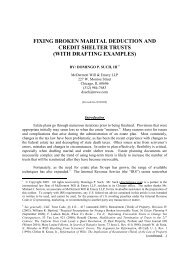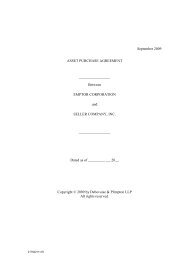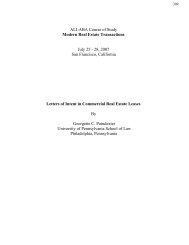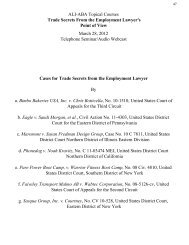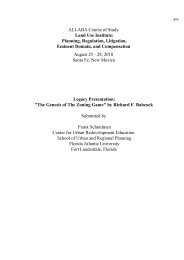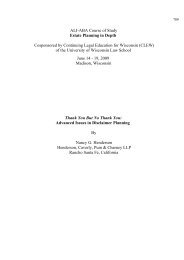Citizen Suits and Defenses Against Them - ALI CLE
Citizen Suits and Defenses Against Them - ALI CLE
Citizen Suits and Defenses Against Them - ALI CLE
You also want an ePaper? Increase the reach of your titles
YUMPU automatically turns print PDFs into web optimized ePapers that Google loves.
464Second, government enforcement prior to commencement of the action may preclude the citizensuit. The prototypical provision precludes citizen suits when, prior to commencement of the citizen suit, astate or federal agency “commences” <strong>and</strong> is “diligently prosecuting” a civil or criminal action “in a Court ofthe United States,” 8 or under the CWA there is diligent prosecution of an administrative action, collection ofa penalty, <strong>and</strong> citizens do not file an action before institution of the agency action or within 120 days ofsending proper notice. 9Third, citizens may “commence” a case only by <strong>and</strong> large in the absence of government enforcementaction. Unless precluded, forestalled, unconstitutional or otherwise unwise, the archetypal citizen suitprovision allows “any person” to “commence a civil action on his own behalf” against either (1) “any person”who violates a legal prohibition or requirement, or (2) the U.S. Environmental Protection Agency (EPA) forfailure “to perform any act or duty . . . which is not discretionary.” 10Each statute has its own temporal jurisdictional requirement as to when an action may be commenced. 11 Forexample, the CWA requires good faith allegations of ongoing violations (that the polluter is “alleged to be inviolation”), 12 while the CAA allows for prosecution of past violations “if there is evidence that the allegedviolation has been repeated,” 13 <strong>and</strong> RCRA for past violations that “may present an imminent <strong>and</strong> substantialendangerment.” 14Last, citizen suits face a banquet of constitutional <strong>and</strong> prudential challenges, including st<strong>and</strong>ing,mootness, preemption, sovereign immunity, the political question doctrine, claim <strong>and</strong> issue preclusion, <strong>and</strong>abstention.<strong>Citizen</strong> suits comprise a significant portion of the judicial canon. Federal courts issued about 220decisions in environmental civil cases in 2010, about 160 of which are environmental citizen suits. 15 Of these,<strong>and</strong> as summarized below, nearly one-half are under the Clean Water Act (74), with the ResourceConservation Act (49), Clean Air Act (34), Endangered Species Act (32), <strong>and</strong> Comprehensive,Environmental Resource Compensation, Liability Act (25) also posting a significant number of judicialopinions, with 54 more cases involving a mash up of statutes. Given this distribution, I’ll start with the CleanWater Act, before turning to the other statutes with citizen suit provisions. For sake of focusing the scope ofthis update, I’ve divided my discussion between “procedural” issues, including notice, preclusion, complaints,jurisdiction, attorney fees, <strong>and</strong> “substantive” decisions that reach the merits, although again, this is by nomeans a scientific distinction.I. Clean Water Act<strong>Citizen</strong>s may bring suit under the Clean Water Act to enforce effluent st<strong>and</strong>ards or limitations set bythe EPA or the State if the violation adversely affects them. <strong>Citizen</strong> suits are barred under the act if diligentstate or federal enforcement is underway. Sixty day notice must be given to the violator, the State, <strong>and</strong> theEPA before filing the suit. Similar to the other citizen suit provisions discussed, to remedy a violation thecourt may issue an injunction, impose penalties, <strong>and</strong> grant attorney’s fees.A. Proceduralproper procedure for raising notice objections, the means of curing notice defects, the question of waiver of noticeobjections, <strong>and</strong> the timing of raising notice objections”).8. See 33 U.S.C. § 1365(b)(1)(B) (2000) (CWA); 42 U.S.C. § 7604(b)(1)(B) (2000) (CAA); 16 U.S.C. §1540(g)(2)(A)(iii) (2000) (ESA); 42 U.S.C. § 6972(b)(1)(B) (2000) (RCRA).9. See 33 U.S.C. § 1319(g)(6)(B) (2000) (CWA). See also 16 U.S.C. § 1540(g)(2)(A)(ii) (2000) (ESA) (preclusion ifServices commence action to impose penalty).10. 42 U.S.C. § 7604(a) (2000).11. R<strong>and</strong>all S. Abate, Rethinking <strong>Citizen</strong> <strong>Suits</strong> for Past Violations of Federal Environmental Laws:Recommendations for the Next Decade of Applying the Gwaltney St<strong>and</strong>ard, 16 Temp. Envtl. L. & Tech. J. 1 (1997); cf.Scott M. DuBoff & Scott W. Clearwater, Arguing for the Defense After Gwaltney, 18 Envtl. L. Rep. 10,123 (1988).12. 33 U.S.C. § 1365(a)(1) (2000) (CWA).13. 42 U.S.C. § 7604(a)(1) (2000) (CAA).14. 42 U.S.C. § 6972(a)(1)(B) (2000) (RCRA).15 These figures are hardly scientific, based on a Lexis search for cases brought as – <strong>and</strong> not simply referencing –citizen suits under one of the statutes cited infra note 4.2




